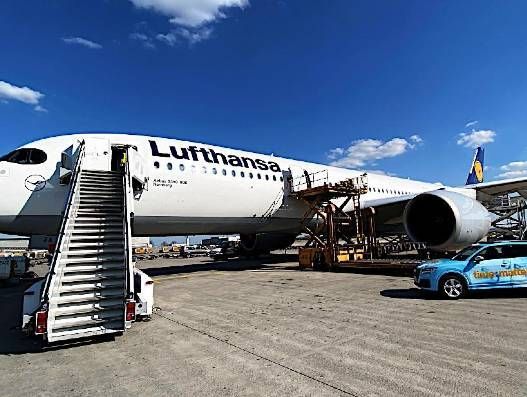
Cargo charters standing right on the frontline to fight Covid-19
Amid the ongoing Covid-19 pandemic, air cargo charter operators continue to pay a critical role in keeping global supply chains alive

When the history of the Covid-19 pandemic will be written, certainly, along with the brave healthcare professionals, we will also see how air cargo charter operations around the world played a crucial role, standing right on the frontline to fight this grave crisis we are in. Even while they are facing challenges, the charter flights are crisscrossing the globe to move PPE, medicines and essentials with exceptional speed and accuracy.
The world is fighting a deadly pandemic and few of us are at the forefront of it by directly facing the crisis and helping people to endure. Along with the healthcare industry with doctors and nurses, air cargo charter operators also emerged as an unlikely saviour during the current crisis by not only moving personal protection equipment (PPE) and pharmaceuticals but also perishables and essentials to when and where it is much needed.
The pandemic has crippled the global supply chain like never before and also precisely when the world so desperately needed it. On the one side the world wants to move PPE and medicines to fight the pandemic while on the other side lockdowns startled the supply chains. The air cargo charters had the solution as they offer the fastest mode of transport right when people need it, irrespective of schedules, passengers and lockdown and they did it.
But air cargo chartering had been operating not without challenges. The stakeholders had to face problems from freight rates to airport congestion, from the absence of feeder flights to permit applications and from customs clearance to crew quarantined.
Jacob Matthew, president & board member, National Air Cargo said, “With complete uncertainty due to Covid-19 and passenger operations halting due to most of the countries closing airports, it became a huge challenge to keep the supply chain continue especially moving super urgent medical supplies and PPE. Charters were the only option since the traditional commercial lanes faded away and the need of the hour was to move relief supplies.”
 |  |
National Air Cargo collaborated with Air Ground Xpress to move PPEs to McKesson Corporation’s distribution centre
Alexander Kohnen, chief executive officer, time:matters said, “Between January and end of February we had an increase in transport requests from companies, which want to equip their branches with urgently needed medical supplies due to the lockdown in China. As a result, we conducted multiple movements of urgently needed medical supplies, such as protective suits, gloves, breathing masks and other relief goods mainly to China but also for instance to Italy.”
Mike Hill, director - group freight, Air Partner said, “In February we were already requested from our clients to move PPE into China and following Covid-19 spread into Europe in March, then the roles reversed with an extreme requirement to move PPE out of China. As China’s production was still restarting following their own lockdown, the early charters were affected by problems in product supply. Within a few weeks, however, there was enough product to supply the vast demand from the numerous nations.”
Mid-March twist
The picture of global air freight changed again after mid-March as the geography of the pandemic changed and spread throughout the world. The direction of air cargo and the chartered operations also got twisted as from Asia to the world.
“From March onwards we have seen, due to the geographical spread of Covid-19, a strong increase in demand for relief goods from China not only to Europe but also to Canada, Brazil, and Israel. In addition, we also conducted several medical supply transport from the USA for companies based in Europe. The requests we received were very diverse and came from governments as well as public authorities, medical institutions, and companies from various industries and countries. We conducted more than 200 charters and utilised several hundred scheduled commercial freighter flights,” said Kohnen.
Hill noted, “When one considers that from mid-March, the passenger aircraft cargo capacity was taken out of the market. Leaving only the freighters. We began our flying into Europe, with B747, 757 and 767 freighters and into the USA with B747 and Antonov 124. However, later in March/early April, the availability of the freighters to Europe was gone as the airframes, we thus turned to charter passenger freighters.”
“Although our “standard” business; aerospace, oil and gas has continued throughout, it has been at a slow pace, due to the universal lockdown. Automotive which was at a standstill during this time is slowly starting up again,” he continued.

Martinair Cargo flies a weekly freighter on the Amsterdam-Cairo route carrying fresh, pharma and aerospace
B747-combi & B777 pax aircraft
The Covid-19 situation has also changed perspective about which aircraft are efficient and suitable to lead the fight against emergencies including a pandemic. 747-combi aircraft of Air France-KLM, B777 passenger flights are some of the examples.
Gertjan Roelands, senior vice president - sales & distribution, Air France KLM Martinair Cargo, informed, “Air France-KLM has dedicated a significant amount of capacity to support governments and businesses with the transportation of PPE and medical equipment. KLM has temporarily brought back the 747-combi aircraft for this purpose. Currently, KLM operates 14 combi flights per week between China and Europe. Air France has rerouted its freighter to support government demand and now operates four 777 full freighter flights per week from China. In addition, both KLM and Air France have introduced cargo-in-cabin making it possible to transport PPE on the seats.”
Matthew recalled, “Initially freighters were the only option, later on, many passenger airline operators deployed passenger aircraft for cargo-only operations. National operated its B757 passenger aircraft on multiple cargo-only missions. Among the passenger aircraft, B777s had an extra advantage since it carries almost a mid-size freighter load on its belly. With overwhelming demand, National also used external B777 passenger capacity to do cargo-only missions.”
Meanwhile, Kohnen informed, “In particular, the airlines belonging to the Lufthansa Group, such as Lufthansa and Austrian Airlines or Sun Express have excelled in their operational flexibility to meet the demands of our customers. Due to the fact that regular passenger flight operations have been more or less suspended since March, various aircraft in the fleet were given a new purpose. The aircraft have been converted to cargo aircraft within a very short time now transporting airfreight mainly from China to Europe. The space on the aircraft seats in the passenger cabin has been used in addition to the cargo capacity in the aircraft belly. In order to fulfill the high demand of our customers, the seats in the aircraft were removed in a further step.”
Hill noted, “In April, IATA released their guidance for cabin loading. Many airlines have since now removed seats from some of their aircraft. As most PPE is volumetric, the passenger 777 for example, has proven to be often a far more economical alternative to traditional freighters, (whilst the rates ex-China were so high) and without seats, even better.”
Shifting routes to Latin America and Africa
Since the pandemic began, there seem to be swift fluctuations in the routes served by air cargo charter operators due to sudden demands popping up from different parts of the world. The primary route is from Asia to the US and Europe due to strong manufacturing happening in China. But there seem to be new divergences to Africa, Latin America, North Atlantic and many other regional destinations.
“The majority of our efforts during the last two months have certainly been with PPE products, on two main trade lanes, Far East to USA and China to Europe. We see now the routes slightly shifting, now from the Far East, to South America and Africa. There now seems to be an abundance of scheduled services serving China to Europe route, with many operators expanding their pre-Covid-19 freighter schedules with their passenger freighters,” said Hill.
Roelands noted, “Carriers slightly increased scheduled operations, although they are still far from pre-Covid-19 levels. The demand for PPE and medical equipment is still stable in Europe but is increasing to other regions like Latin America. Most charter operations are from Asia to Europe. AF and KLM have also been rapidly increasing its scheduled network to Asia. Also, North Atlantic routes are important, as they were never really ‘freighter heavy’, but more served by passenger aircraft which almost came to a halt when the US and the Schengen area introduced their travel bans.”
Matthew added, “There are strong demands coming up from regions where the regional carriers have insufficient freighter capacity to cope with the demand.”
Challenges in air cargo chartering
The air cargo charter operations during Covid-19 was far from being smooth since the stakeholders had to face issues like cargo backlogs, regulatory changes and Covid-19 quarantines. The air cargo operators were equally innovative in finding solutions.
“For example, we faced a situation that the road and warehouse utilisation at Shanghai Pudong International Airport (PVG) is at a high level due to rising demand for freight capacity and changed customs procedures out of China. We have therefore reacted quickly and opened up new possibilities for our customers’ express air freight. As already mentioned before, we can offer to fly time-critical shipments also from other, less congested Chinese airports, including freighter solutions from Nanjing (NKG), Xiamen (XMN) and Beijing (PEK) and Shenzhen (SZX),” said Kohnen.
Hill noted that “changes in the charter permit application process in China caused some early headaches, and then later there were new customs regulations as well as widespread congestion in the main Chinese freight airports, which caused some delays in getting cargo to the aircraft.”
Matthew informed, “Travel restriction to many countries is still a big issue even while operating freighters internationally. Carriers are restricted to key gateway points only with crew positioning and de-positioning became a big challenge. As more and more countries open up for travel, the cargo movements will also get faster to more points world-wide, avoiding delays using feeders at regional levels. Opening up of more regional gateways will help the key feeder operators to resume operations to other regional points from the main hub. In places like India freight community went almost shut down mode in between since road movements were highly restricted.”
Air freight charter rates
Covid-19 imposed immense challenges on the global logistics world. For numerous airlines, passenger flights came to a near standstill or were completely suspended. As a result belly capacities were no longer available. The demand on the one hand and shortage of available airfreight capacities on the other led to higher purchasing and freight rates right from the beginning of the pandemic.
Hill noted, “The China-Europe freight rates increased three fold during this time, but recently they have dropped back down again, to around two-fold, due to the ever-increasing capacity and slowing demand. There is still less capacity than in pre-Covid-19 times, but there is also less demand for non-PPE cargo movements, compared to pre-Covid-19.”
Matthew said, “Asia to US rates went up from $3 per kg to almost $25 per kg among the consolidators and major forwarders with restricted capacity and extremely high demand. However, the rates went high primarily for high demand PPE movements, compared to general cargo.”
Traditional commercial lanes fed by passenger aircraft cargo capacity will take time to get back to the old normal. Freighter operations will be key during these current times. Though the initial extraordinary demand started slowing down, the commercial cargo movements are gearing up and are keeping the demand high for large capacity providers.

